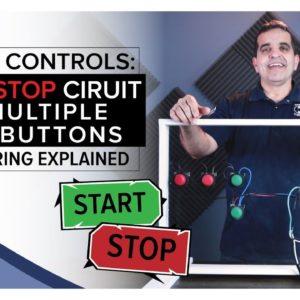hey everybody this is Walter with Access Electric and we're back today doing a three wire start/stop video once again. I know we have another three wire start/stop video, but I've received a couple comments on that video requesting some more information about the field wiring of a three wire start/stop. So here in front of us I have a three wire start/stop with multiple start buttons and multiple stop buttons and what I wanted to do on today's video is we're going to show you the same schematic I showed you before but we're gonna show you a little bit, or we're gonna take a little bit more time showing you the individual components what a normally open means what a normally closed mean what an auxilary contact is and show you how that's wired up in relation to the drawing so you can get a big, a bigger picture or a better picture of what that looks like.
So stick with us as we go through a three wire multiple start/stop! [Music] So here we have our power coming in. Our power comes in on this cord and it feeds a breaker. And I'll turn that breaker on. That breaker comes on and it it feeds only this black wire right here and it's feeding our stop button so it feeds the first stop button. This black wire comes across here comes all the way to the end and feeds our first stop button. Our Neutral comes out of our cord it's going directly to our overload on our starter and the other side is going through the overload and coming up and feeding one side of our motor starter coil. Okay so power comes up to our first stop button and now the stop button has a normally closed contact. That means power travels through the normally closed contact when no one's pushing the button.
Power is going through the switch. If you push the button the normally closed contact opens and power is cut in half and stops flowing. But when I let go of the button the button closes the contacts close and power goes through the contact. Power will then go to the next normally closed stop button. And again power goes through the stop button until somebody pushes it. If you're pushing it, the switch will open power will stop flowing. With no one touching it power flows through. These are normally closed switches. And now then I have my two start buttons and if you see here I've laid them out this way so you can see the stop buttons are in series with one another so power needs to run through the first one and then through the second one. It has to be this switch and this switch have to be closed for power to continue. That is a series circuit both have to be closed to close the circuit. Then we come to our stop buttons and I've put them in this configuration… did I say stop buttons I mean start buttons. Here I have the start buttons and I've put them in this configuration because start buttons are wired in parallel.
That means it can be one start button or the other start button. One or the other will start this motor control, this motor starter; One start button or the other. So these start buttons are normally open that means both of these switches are open. The contacts are not connected until somebody pushes the button. And now our starter is going to start because I closed the contact, when I push the button. When I let go the contact opens but our starter is still on.
And we'll get to that holding contact here in a minute. So either one of these start buttons will start our contactor. Alright, then we go through our stop button through the other stop button we feed one side of our start button. Here I have this wire comes in, it feeds this side of the start this start button and it feeds the same side of the next start button. They are in parallel with one another. And then I have this blue wire coming off of this start button which goes directly to the coil on my starter. The coil on the starter this is what creates the electromagnetism that turns this contactor on; that actually closes this contactor. I need to create an electromagnet to pull this contactor in and close this motor control circuit. So this blue wire, both of these blue wires, are connected together and go directly to my coil.

So when I energize this blue wire the coil will start. And finally this red wire. If you remember this black wire is energized, the switch is closed so this black wire is energized. This other stop button is closed so this this is energized. This is energized as well. And so the red wire here is connected to this black wire. This are holding wire, so when everything is a normal position this red wire is energized and it comes over, comes through my plexiglass cover here, and it comes and it feeds one side of this normally open contact.
This is called an auxilary contact. Again a normally open means it's not connected. It is open. It only closes when this coil is energized this switch will close. So when I push the start button I energize this blue wire which closes the contactor. This red wire is already energized because all my stop buttons are in normal position. This red wire is already energized so power will then flow through this switch, which just closed when I powered the blue wire, it just closed now I have power, continuous power, whether I'm holding the start button at all. I have continuous power keeping the coil on. That's how it works, so I wanted to take some close-ups of these buttons so you understand, or you can see what normally open, normally closed is, and as I'm going through all this you should be able to see this on the screen as well as we go through the schematic. So there you have it. This is the basics of motor control if you can understand a three wire start/stop, understand what these are, everything is just switching.
You have normally closed type switches. Normally open type switches. You have another normally open type switch here. This this overload right here is a normally closed switch. Which actually, if if our starter is running, and I were to trip this overload, the starter will stop because it lost its neutral. So I lost one side of the circuit feeding this coil. You have to have a complete circuit to have this motor starter operate. So by tripping the overload I lost half the circuit and the starter stops. let me start this thing back up again. There you have it. So there you have it three wires start/stop. The basics of motor control. Practice, get this down. There's a lot more things we can learn but for this week it's three wire start stop.
Hey, thanks for watching these videos. If you like this video, hit the thumbs up. Don't forget to subscribe, and press the bell icon for more notifications. In the meantime, have a great day and we'll see you in the next video..

